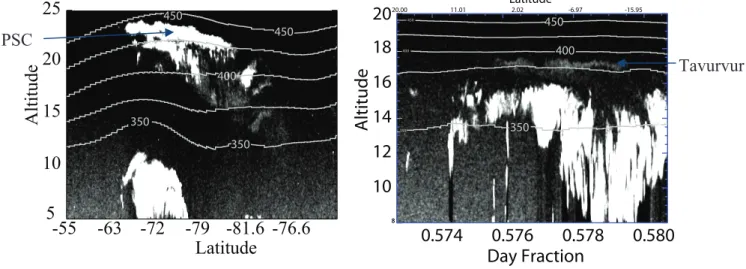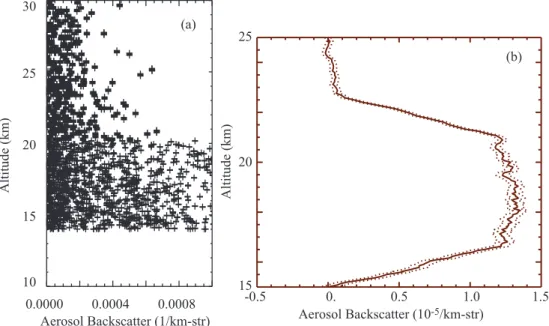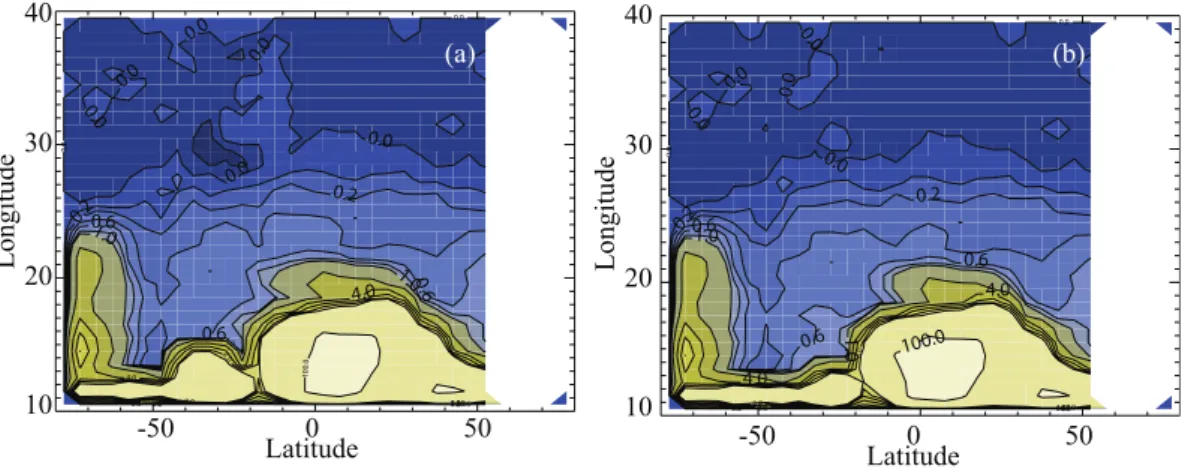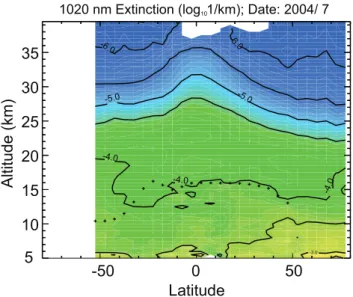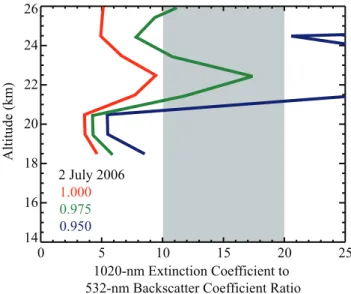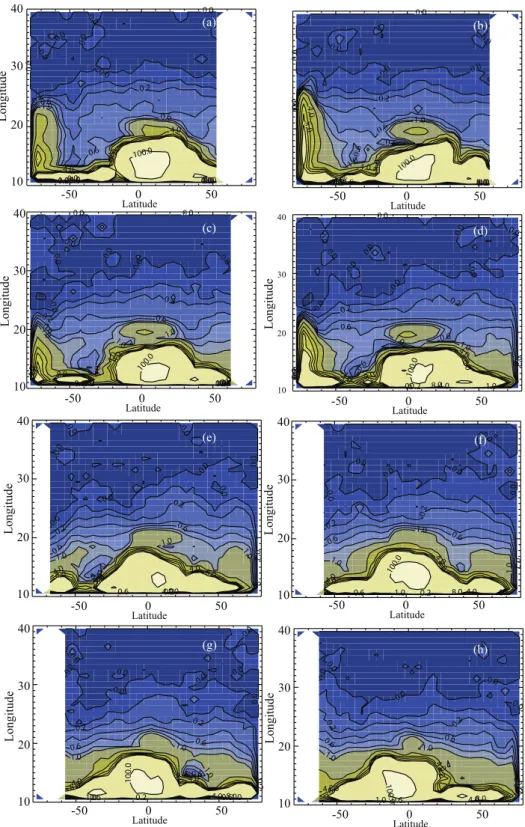HAL Id: hal-00296356
https://hal.archives-ouvertes.fr/hal-00296356
Submitted on 15 Oct 2007
HAL is a multi-disciplinary open access
archive for the deposit and dissemination of
sci-entific research documents, whether they are
pub-lished or not. The documents may come from
teaching and research institutions in France or
abroad, or from public or private research centers.
L’archive ouverte pluridisciplinaire HAL, est
destinée au dépôt et à la diffusion de documents
scientifiques de niveau recherche, publiés ou non,
émanant des établissements d’enseignement et de
recherche français ou étrangers, des laboratoires
publics ou privés.
CALIPSO observations of stratospheric aerosols: a
preliminary assessment
L. W. Thomason, M. C. Pitts, D. M. Winker
To cite this version:
L. W. Thomason, M. C. Pitts, D. M. Winker. CALIPSO observations of stratospheric aerosols: a
preliminary assessment. Atmospheric Chemistry and Physics, European Geosciences Union, 2007, 7
(20), pp.5283-5290. �hal-00296356�
© Author(s) 2007. This work is licensed under a Creative Commons License.
Chemistry
and Physics
CALIPSO observations of stratospheric aerosols: a preliminary
assessment
L. W. Thomason1, M. C. Pitts1, and D. M. Winker1
1NASA Langley Research Center, Hampton, VA, USA
Received: 29 March 2007 – Published in Atmos. Chem. Phys. Discuss.: 26 April 2007 Revised: 1 August 2007 – Accepted: 27 September 2007 – Published: 15 October 2007
Abstract. We have examined the 532-nm aerosol backscat-ter coefficient measurements by the Cloud-Aerosol Lidar and Infrared Pathfinder Satellite Observations (CALIPSO) for their use in the monitoring of stratospheric aerosol. CALIPSO makes observations that span from 82◦S to 82◦N
each day and, for each profile, backscatter coefficient values reported up to ∼40 km. The possibility of using CALIPSO for stratospheric aerosol monitoring is demonstrated by the clear observation of the 20 May 2006 eruption of Montserrat in the earliest CALIPSO data in early June as well as by ob-servations showing the 7 October 2006 eruption of Tavurvur (Rabaul). However, the very low aerosol loading within the stratosphere makes routine observations of the strato-spheric aerosol far more difficult than relatively dense vol-canic plumes. Nonetheless, we found that averaging a com-plete days worth of nighttime-only data into 5-deg latitude by 1-km vertical bins yields a stratospheric aerosol distri-bution that is fairly consistent with past measurements by spaceborne instruments. Based on comparisons with 2004 data from the Stratospheric Aerosol and Gas Experiment, the derived values are close to expectation except in the tropics where they are larger by about a factor of 2. The cause of the difference in the tropics is not readily apparent but is most likely related to difficulties in the lidar calibration process currently found in the CALIOP data at tropical latitudes.
1 Introduction
Aerosol plays a significant role in the chemistry and dynam-ics of the lower stratosphere and upper troposphere includ-ing a critical role in the heterogeneous processes that lead to ozone destruction. Stratospheric aerosol is also highly variable due to episodic volcanic eruptions that inject aerosol
Correspondence to: L. W. Thomason
(l.w.thomason@nasa.gov)
and/or its gaseous precursors into the stratosphere. Over the last 25 years, the total aerosol loading has varied by more than a factor of one hundred and volcanic effects have dom-inated other natural and human-derived sources for strato-spheric aerosol in all but the last few years when levels have apparently reached a stable background level (Thomason and Peter, 2006). In the absence of another volcanic eruption, aerosol levels may still undergo significant changes over the next decade due to changes in the human-derived aerosol pre-cursors. Global human-derived SO2has declined by nearly
20% since 1980 (Stern, 2003). On the other hand, emissions in East Asia and China have increased dramatically over this period and are projected to continue to increase. It is be-lieved that SO2or SO2-derived aerosol can reach the upper
troposphere/lower stratosphere (UTLS) through entrainment by deep convection in the tropics and, since SO2has a short
lifetime in the troposphere, emissions at low latitudes are far more likely to attain the tropical tropopause than mid-latitude emissions (Notholt et al., 2006). As a result, it is possible that changes in human-derived SO2 concentration
in the lower stratosphere may produce either an increase or decrease in aerosol loading in the lower tropical stratosphere in the coming years. Changes in aerosol in the UTLS may affect the occurrence and properties of thin cirrus in this ra-diatively sensitive region (e.g., K¨archer, 2002).
As a result, measurements of stratospheric aerosol remain important, yet global measurements by space-borne instru-ments are at risk due to the end of the missions of sev-eral long-lived instruments (e.g., the Stratospheric Aerosol and Gas Experiment (SAGE II/III), The Halogen Occulta-tion Experiment (HALOE), and the Polar Ozone and Aerosol Measurement (POAM III)) and instrument performance is-sues for on-going missions (the High Resolution Dynamics Limb Sounder or HIRDLS). Several instruments have the potential to produce stratospheric aerosol data products but have yet to produce them operationally (e.g., SCIAMACHY, ACE-FTS, and MAESTRO). In light of this, we examine the
5284 L. W. Thomason et al.: CALIPSO observations of stratospheric aerosols
0.574
0.576
0.578
0.580
Day Fraction
810
12
14
16
18
20
Altitude
8 350 350 350 400 400 450 450 20.00 11.01 2.02 -6.97 -15.95 Latitude5
10
15
20
25
Altitude
350 400 450 450-55
-63
-72
-79
-81.6 -76.6
Latitude
350Tavurvur
PSC
Fig. 1. CALIOP observations of (a) a PSC observed on 24 July 2006 and (b) a qualitative depiction of the volcanic plume from the 7 October
2006 Tavurvur eruption as measured on 15 October 2007. In both frames, the solid grey lines denote potential temperature.
Table 1. CALIOP instrument characteristics.
laser: Nd: YAG, diode-pumped, Q-switched, frequency doubled wavelengths: 532 nm, 1064 nm
pulse energy: 110 mJoule/channel repetition rate: 20.25 Hz
receiver telescope: 1.0 m diameter polarization: 532 nm footprint/FOV: 100 m/ 130 µrad vertical resolution: 30–60 m horizontal resolution: 333 m linear dynamic range: 22 bits data rate: 316 kbps
Cloud-Aerosol Lidar and Infrared Pathfinder Satellite Ob-servations’ (CALIPSO) Cloud-Aerosol Lidar with Orthogo-nal Polarization (CALIOP) lidar backscatter coefficient pro-files at 532 nm as a potential source of a scientifically useful stratospheric aerosol product. While we concede that this is challenging, our preliminary study (explained in detail be-low) suggests that a scientifically viable data product is pos-sible even for the very low aerosol loading period currently observed.
2 CALIPSO stratospheric aerosol measurements 2.1 Description of CALIPSO
The primary objective of CALIPSO is to provide measure-ments that will significantly improve our understanding of the effects of aerosols and clouds on the climate system
Table 2. CALIOP spatial resolution of downlinked data.
Altitude Horizontal Vertical Range (km) Resolution (km) Resolution (m)
30.1–40.0 5.0 300
20.2–30.1 1.67 180
8.2–20.2 1. 60
−0.5–8.2 0.33 30
−2.0–−0.5 0.33 300
(Winker et al., 2007). As part of the Aqua satellite constel-lation that includes the Aqua, CloudSat, Aura, and PARA-SOL satellites, CALIPSO is in a 98◦inclination orbit with
an altitude of 705 km that provides daily global maps of the distribution of aerosol and clouds. The CALIPSO pay-load consists of three instruments: the Cloud-Aerosol Li-dar with Orthogonal Polarization (CALIOP), an Imaging In-frared Radiometer (IIR), and a moderate spatial resolution Wide Field-of-view Camera (WFC). CALIOP provides pro-files of backscatter at 532 and 1064 nm, as well as two orthogonal (parallel and perpendicular) polarization com-ponents at 532 nm. CALIOP instrument characteristic are shown in Table 1 and the vertical and horizontal resolution of the data products is shown in Table 2. A detailed dis-cussion of CALIOP data products can be found in Vaughan et al. (2004). In the routine processing, the parallel compo-nent of the 532-nm backscatter is calibrated to the expected molecular volume backscatter coefficient between 30 and 34 km altitude where the molecular density is derived from the GEOS-4 atmospheric analyses provided by the Global Modeling and Assimilation Office (Bloom et al., 2005; Lin, 2004). The current calibration algorithm does not account
0.0000 0.0004 0.0008 Aerosol Backscatter (1/km-str) 10 15 20 25 30 Altitude (km) 15 Altitude (km) 25 20 0. 0.5 1.0 1.5 -0.5 Aerosol Backscatter (10-5/km-str) (a) (b)
Fig. 2. (a) A depiction of 100 individual simulated CALIPSO 532-nm backscatter profiles for stratospheric layer between 15 and 23 km. The
abrupt change in noise at 20 km is due to a change in on-board smoothing and not due to any atmospheric signal. (b) Simulated retrieval of a stratospheric aerosol layer using CALIPSO backscatter data. This profile is a 1-day, 5-deg latitudinal average for background conditions.
for possible stratospheric aerosol in the 30–34 km region, as there are currently no available independent global measure-ments. Independent calibrations occur every 55 km of the dark side of each orbit and are smoothed using a 27-point mean (1485 km) (Hostetler et al., 2006) and interpolated onto the sunlit side. The perpendicular component is transferred from the parallel term using an on-board optical system. The calculation of a stratospheric aerosol product is highly sensi-tive to the quality of this normalization and any deficiency in the calibration represents the greatest obstacle to the success-ful production of a scientifically useable stratospheric aerosol product.
2.2 Initial assessment
With its first observations in mid-June 2006, CALIPSO pro-vided detail of condensed material within the stratosphere. These observations included polar stratospheric clouds (Pitts et al., 2007) as shown in Fig. 1a and a distinct aerosol plume associated with the 20 May 2006 eruption of Montserrat (e.g., Carn et al., 2007). Figure 1b is an example of the obser-vations of a second volcanic event that appeared in the lower tropical stratosphere following the 7 October 2006 eruption of Tavurvur. This plume remained clearly observable in the tropics to at least the end of November 2006. However, apart from these kinds of events, CALIOP backscatter data does not readily show the presence of the stratospheric aerosol layer that has been regularly measured in the past by in-struments such as SAGE II and HALOE (see, for exam-ple, the browse images at http://www-calipso.larc.nasa.gov/ products/lidar/index.php).
Currently, the mid-latitude stratospheric aerosol column total backscatter (often referred to as integrated backscatter) lies between 2 and 7×10−5str−1at 532 nm and most of this
aerosol lies within 5 to 6 km of the tropopause (Vaughan and Wareing, 2004). In the main aerosol layer, the to-tal backscatter to molecular-only backscatter ratio (often called the backscatter ratio) is between 1.03 and 1.06. The backscatter ratio can increase above the main aerosol layer due in part to the rapid decrease in molecular backscatter with altitude. The integrated column back scatter is about a factor of 100 less than that following the 1991 Pinatubo eruption and also much less than what can be observed in the boundary layer. With such low values, it is not sur-prising that stratospheric aerosol was not a science target of the CALIPSO mission. To test the feasibility of pro-ducing a stratospheric 532-nm aerosol backscatter product from CALIPSO, we began by making use of the CALIOP data simulator developed by the CALIPSO data processing team (Powell et al., 2002). This simulator includes all known sources of measurement error including shot noise and elec-tronic performance. As input we used a column total of 7.2×10−5str−1at 532 nm that corresponds to the upper end
of ground-based lidar measurements and, based on a 1020nm extinction coefficient to 532-nm backscatter coefficient ratio of 20 str, is roughly consistent with the stratospheric aerosol optical depth at 1020 nm reported by SAGE II (∼0.0015). Our backscatter profile is a constant 1.2×10−5km−1 str−1
between 17 and 21 km and linearly decreases to zero by 15 and 23 km. We then produced a 20 000-km track using the CALIPSO lidar data simulator. The output was produced at
5286 L. W. Thomason et al.: CALIPSO observations of stratospheric aerosols 0.0 0.0 0.0 0.0 0.0 0.0 0.0 0.0 0.2 0.2 0.2 0.2 0.6 0.6 0.6 0.6 0.6 1.0 1.0 1.0 1.0 1.0 4.0 4.0 4.0 4.0 8.0 8.0 8.0 100.0 -50 0 50 Latitude 10 20 30 40 Longitude 0.0 0.0 0.0 0.0 0.0 0.0 0.0 0.2 0.2 0.2 0.2 0.6 0.6 0.6 0.6 0.6 1.0 1.0 1.0 1.0 4.0 4.0 4.0 4.0 8.0 8.0 8.0 100.0 (b) (a) 10 20 30 40 Longitude -50 0 50 Latitude
Fig. 3. CALIPSO stratospheric 532-nm aerosol backscatter profiles for (a) 2 July 2006 including all latitudes and longitudes and (b) the
same day with all observations between 0◦and 60◦S and 30◦E and 90◦W. The contour values are −0.1, 0, 0.1, 0.2, 0.4, 0.6, 0.8, 1, 2, 4, 6,
8, 10, and 100 for aerosol backscatter coefficient in km−1str−1times105. Areas in the troposphere with extinction coefficient values greater
than 10−4km−1str−1(contour label “10”) are strongly influenced by the presence of cloud. Areas within the Antarctic winter time polar
vortex show enhanced backscatter due to the presence of polar stratospheric clouds.
the nominal resolution reported by CALIPSO of 1 km along track and 60 m vertical resolution below 20 km and 5/3 km along track and 180 m vertical resolution above 20 km. We simulated only nighttime measurements in light of the low backscatter levels and noting that nighttime measurements have a much higher signal-to-noise ratio than daytime mea-surements.
Figure 2a shows 100 individual profiles of this data be-tween 14 and 30 km. Other than the change in resolution (see Table 2) at 20 km, there are no obvious features in this figure and the aerosol layer is invisible. The abrupt change in noise at 20 km is due to the change in on-board smooth-ing and not due to any atmospheric signal. Fortunately, there is no overriding reason to produce stratospheric aerosol data at anywhere close to this resolution. The most prominent existing stratospheric aerosol measurement data sets, SAGE II and HALOE, are made by solar occultation and provide a total of only 30 profiles a day and have a horizontal ex-tent of hundreds of kilometers (Thomason et al., 2003). As a result, we feel that substantial averaging to produce a strato-spheric product is justifiable and initial assessments of data quality support this conclusion (Winker, et al., 2007). At the same time, given the lack of operational global strato-spheric aerosol measurements, even coarser averaging than that representative of current analyses could be justified as a mechanism to preserve stratospheric record. Figure 2b shows the result of reducing the resolution to 1.5 km vertically and averaging along 15 tracks through a 5-deg latitude band (a total ground track of 7500 km) or essentially, a 1-day zonal average. At this resolution, the aerosol layer is clearly visi-ble and the uncertainty in the mean profile is only about 1%. While the simulator is as realistic as possible, it no doubt is missing some components of the measurement noise that are observed in the real data. As a result, we recognize that it
is necessary to explore various techniques to produce robust stratospheric aerosol profiles including along track averag-ing, vertical averagaverag-ing, and zonal averaging.
2.3 Application to CALIPSO measurements
As the initial stratospheric aerosol grid, we chose daily meridianal analyses of all 14/15 nighttime orbit segments av-eraged in 5-degree latitude bins between 80◦S and 80◦N and
1km altitude bins covering from 10 to 40 km. This resolu-tion is much less fine than that reported in the standard data product files and spans several changes in horizontal and ver-tical resolutions in these files (see Table 2). The total number of profiles going into the analysis is on the order of 8×105 though replication of data points to account for changes in resolution reduces the effective number of independent mea-surements. Nonetheless, the volume of data is significantly greater than has been previously available. For instance, the daily number of profiles is almost twice as many profiles as SAGE II produced during its 21-year lifetime. For the initial assessment, we have not made an effort to eliminate cirrus clouds or PSCs. In the future, we will use more sophis-ticated methods including the use of additional CALIPSO observations such as the 532-nm perpendicular backscatter coefficient and 1064-nm total backscatter coefficient mea-surements to more effectively deal with the presence of all clouds (e.g., Pitts et al., 2007). The Level 1 backscatter data product (v1.10) is attenuated backscatter which we correct for molecular backscatter and the attenuation by molecules and ozone for the two way trip between the measurement al-titude and the spacecraft. We do not currently correct for aerosol attenuation but is very small in the stratosphere at current loadings where the backscatter values are exceed-ingly small. As a result, while the backscatter values we
1020 nm Extinction (log10 1/km); Date: 2004/ 7 -50 0 50 Latitude 5 10 15 20 25 30 35 Altitude (km) -6.0 -6.0 -5.0 -5.0 -4.0 -4.0 -4.0 -3.0
Fig. 4. Cross section of 1020-nm aerosol extinction for July 2004
as measured by the solar occultation instrument SAGE II (in km−1
in log10). The “+” signs denote the mean tropopause height. This
analysis uses the method developed by Kent et al. (1993) to remove the effect of clouds.
report will underestimate true values, we believe that the use of aerosol attenuated backscatter is unlikely to have a signif-icant effect on the analysis.
Figure 3a shows the aerosol backscatter coefficient merid-ianal cross section for 2 July 2006. At first glance, the dis-tribution is fairly reasonable. Generally, it decreases above the tropopause except at high southern latitudes where po-lar stratospheric clouds are frequently observed (Pitts et al., 2007). Since we are not clearing clouds, it is not surpris-ing that the backscatter coefficient increases rapidly below the tropopause particularly in the tropics. There is also a tendency for stratospheric data in the southern hemisphere to show substantial pathologic noise that is associated with the South Atlantic Anomaly (SAA). The SAA is a region where the Van Allen radiation belt dips closest to the Earth’s surface and, in this case, exposes CALIOP to increased ra-diation levels and resultant instrument noise that have made handling this stratospheric data difficult at this juncture. Fig-ure 3b shows the same day in which we have eliminated all data between 0◦ and 60◦S and 30◦E and 90◦W. We have
found this to be an effective filter for this analysis and apply it the rest of our analyses.
For comparison purposes, we offer a mean meridianal SAGE II aerosol extinction analysis from July 2004 as shown in Fig. 4. This is a fair comparison because SAGE II is a well-known and well-validated stratospheric aerosol data set and stratospheric aerosol has been relatively constant since 2000 (e.g., Deshler et al., 2006) apart from minor effects by volcanic eruptions such as those by Montserrat and Tavurvur. Figure 3b shows substantial regions that are at least
reminis-0 5 10 15 20 25 14 16 18 20 22 24 26 Altitude (km) 1020-nm Extinction Coefficient to 532-nm Backscatter Coefficient Ratio
NH Mid Lat. SH Mid Lat. Equatorial 2 July 2006
Fig. 5. (a) The ratio of 1020-nm aerosol extinction to 532-nm
aerosol backscatter (solid) and the ratio of 1020-nm aerosol ex-tinction to 1064-nm aerosol backscatter as a function of radius for spherical sulfate aerosol at stratospheric temperatures. (b) Ratio of SAGE II 1020-nm aerosol extinction to the 532-nm CALIOP aerosol backscatter coefficient in northern mid-latitudes (green), equatorial (red), southern mid-latitudes (blue) for 2 July 2004. The shaded grey area roughly covers the expected range of the ratio val-ues.
cent of the aerosol layer shown in Fig. 4. Based on a 532-nm extinction to backscatter coefficient ratio of approximately 50 (J¨ager and Deshler, 2002, 2003) and a measured SAGE II 525 to 1020-nm extinction ratio between 3 and 4 (Thomason et al., 2007), the expected value for the 1020-nm extinction to 532-nm backscatter ratio is between 10 and 20 str. The range roughly corresponds to mean particle size where smaller ra-tios imply smaller aerosol. This range of values can be in-ferred from Fig. 5a that shows the ratio of the backscatter and extinction Mie kernels for sulfate aerosol with radii be-tween 0 and 0.5 µm. There is a potential for smaller values of 1020-nm extinction to 532-nm backscatter coefficient ra-tio when dominating particle radius is less than 0.1 µm pos-sibly occurring in regions of the stratosphere where intense particle formation is occurring.
Figure 5b shows the ratio of the SAGE II 1020-nm ex-tinction coefficient (from July 2004) to the CALIOP 532-nm backscatter coefficient at northern and southern mid-latitudes (40◦)and the equator. The mid-latitude values in
both hemispheres are similar and average ∼12 str between 16 and 24 km with the southern hemisphere ratio slightly smaller than for the northern hemisphere. The value is quite variable above 24 km where the backscatter coefficient lev-els decrease rapidly. This value is within the expected range and suggests that the CALIOP data holds some promise for stratospheric applications. On the other hand the ratio at the equator runs between 3 and 7 or something less than half of
5288 L. W. Thomason et al.: CALIPSO observations of stratospheric aerosols 0 5 10 15 20 25 14 16 18 20 22 24 26 Altitude (km) 1020-nm Extinction Coefficient to 532-nm Backscatter Coefficient Ratio 1.000
0.975 0.950 2 July 2006
Fig. 6. Ratio of SAGE II 1020-nm aerosol extinction to the 532-nm
CALIOP aerosol backscatter at the equator for the standard product (red), adjusted by a factor of 0.975 (green) and by a factor of 0.95 (blue) for 2 July 2004. The shaded grey area roughly covers the expected range of the ratio values.
the expected value. At and below 20 km, the small value is at least partly due to the enhanced backscatter coefficient layer that is the most prominent feature shown in Fig. 5b. This fea-ture is non-depolarizing and therefore not ice or other solid condensed material and is most likely due to the remnant of the Montserrat eruption or other processes discussed below. Above 20 km, the ratio appears to be much too small. It is possible that it is due to variations in the lidar calibration constant that shows a maximum in the tropics. The diffi-culty in measuring the calibration coefficient in the tropics is due to the need for substantial molecular backscatter with the absence of significant aerosol backscatter. Currently the cal-ibration process assumes a pure molecular atmosphere above 30 km at all latitudes. On the other hand, Fig. 4 shows that SAGE II measured significant aerosol extinction above 30 km and that it is approximately 3 times higher in the tropics than at mid and high latitudes. Based on the 2004 SAGE II data, our best estimate is that the backscatter ratio at these altitudes in the tropics is actually at least 1.03 and possibly as large as 1.10 (CALIOP ATDB, 2006). The discrepancy of 3 to 10% in backscatter ratio translates into a similar magni-tude over-estimate of the calibration coefficient for the entire depth of the profile and roughly into an underestimate of the total backscatter coefficient of the same magnitude.
To evaluate the effect of the calibration issue on the strato-spheric aerosol backscatter, we performed an experiment by adjusting the equatorial total backscatter profile from Fig. 5b by a multiplicative constant, remove the computed molecular backscatter, correct for molecular and ozone attenuation and ratio to the corresponding SAGE II 1020-nm extinction
pro-file. Since we need the backscatter to increase, we multiply the total CALIOP 532-nm backscatter coefficient profile by 0.975 and 0.95 and the resulting 1020-nm extinction to 532-nm backscatter coefficient profiles are shown in Fig. 6. Pro-gressively decreasing the total backscatter clearly moves the ratio toward (and through) the range of ratio we expected and suggests that a decrease in total backscatter of a few percent in tropics would improve the data product. Curiously, this change is in the opposite sense that the failure to account for aerosol above 30 km in the calibration process would push the result. This suggests that either the calibration issue is more complicated than is currently believed or that a geo-physical process (e.g., new particle formation) is responsible for moving the extinction-to-backscatter ratio away from ex-pected values. One possible method to produce this error would be a few percent bias in the density data that is used for CALIOP calibration. Further study should help clarify this issue.
2.4 Some illustrative results
Figure 7 shows a series of daily cross sections (1 day every 4 weeks) of 532 nm aerosol backscatter coefficient for July 2006 through January. No tropical calibration correction has been included in these images. Here we see very regular be-havior in each frame that shows a stratospheric aerosol layer that stretches from about 15 km to around 22 km. There is a persistent maximum magnitude in the lower tropical strato-sphere that generally decreases in magnitude with time. At this point, it is not clear what the primary source of this fea-ture is, however, it is likely that it is related either to the May 2006 Monserrat eruption or a lower tropical aerosol an-nual cycle that peaks in the second half of the calendar year as has been reported by Thomason et al. (2007). The in-crease of backscatter coefficient in the lower stratosphere in late 2006 in the southern hemisphere is due to aerosol origi-nating with the October 2006 Tavurvur eruption that appears to have been transported preferentially to southern latitudes in late 2006 in fashion similar to the 1990 eruption of Kelut (Thomason et al., 1997). The presence of PSCs is clearly ev-ident in the southern hemisphere through the 24 September image (Fig. 7d) whereas no clear presence PSCs is noted in the northern hemisphere is observed in December or January (Figs. 7g and 7h).
3 Conclusions
On the basis of this analysis, we believe that CALIPSO lidar measurements hold some promise for stratospheric applica-tions. The development of a CALIPSO stratospheric aerosol product may provide a bridge between past stratospheric aerosol-measuring instruments like SAGE II and HALOE and future instruments like the Ozone Mapping and Profiler Suite (OMPS). Linking these aerosol data sets is important to
-50 0 50 Latitude 10 20 30 40 Longitude 0.0 0.0 0.0 0.0 0.0 0.0 0.0 0.2 0.2 0.2 0.2 0.6 0.6 0.6 0.6 0.6 1.0 1.0 1.0 1.0 4.0 4.0 4.0 4.0 8.0 8.0 8.0 100.0 0.0 0.0 0.0 0.0 0.0 0.0 0.0 0.0 0.2 0.2 0.2 0.2 0.6 0.6 0.6 0.6 0.6 1.0 1.0 1.0 1.0 1.0 4.0 4.0 4.0 8.0 8.0 8.0 8.0 100.0 0.0 0.0 0.0 0.0 0.0 0.0 0.0 0.0 0.0 0.0 0.2 0.2 0.2 0.2 0.2 0.6 0.6 0.6 0.6 6 . 0 0.6 1.0 1.0 1.0 1.0 1.0 4.0 4.0 4.0 4.0 8.0 8.0 8.0 8.0 100.0 0.0 0.0 0.0 0.0 0.0 0.0 0.2 0.2 0.2 0.2 0.6 0.6 0.6 0.6 1.0 1.0 1.0 1.0 4.0 4.0 4.0 8.0 8.0 8.0 100.0 0.0 0.0 0.0 0.0 0.0 0.0 0.0 0.0 0.2 0.2 0.2 0.2 0.6 0.6 0.6 0.6 0.6 1.0 1.0 1.0 1.0 1.0 4.0 4.0 4.0 8.0 8.0 8.0 100.0 0.0 0.0 0.0 0.0 0.0 0.0 0.0 0.0 0.2 0.2 0.2 0.2 0.6 0.6 0.6 0.6 0.6 1.0 1.0 1.0 1.0 1.0 4.0 4.0 4.0 4.0 8.0 8.0 8.0 0.0 0.0 0.0 0.0 0.0 0.0 0.2 0.2 0.2 0.2 0.6 0.6 0.6 0.6 1.0 1.0 1.0 1.0 4.0 4.0 4.0 8.0 8.0 8.0 100.0 10 20 30 40 Longitude 10 20 30 40 Longitude 10 20 30 40 Longitude 10 20 30 40 Longitude 10 20 30 40 Longitude 10 20 30 40 Longitude -50 0 50 Latitude -50 Latitude0 50 -50 0 50 Latitude -50 Latitude0 50 -50 0 50 Latitude -50 Latitude0 50 (a) (c) (d) (e) (f) (g) (h) 0.0 0.0 0.0 0.0 0.0 0.0 0.2 0.2 0.2 0.2 0.6 0.6 0.6 0.6 0.6 0.6 1.0 1.0 1.0 1.0 1.0 4.0 4.0 4.0 4.0 8.0 8.0 8.0 8.0 100.0 -50 0 50 Latitude (b)
Fig. 7. Cross sections of CALIOP aerosol attenuated backscatter at 532 nm where the total backscatter has been adjusted for molecular and
ozone attenuation and areas impacted by the SAA have been excluded for (a) 2 July 2006, (b) 31 July 2006, (c) 26 August 2006, (d) 24 September 2006, (e) 22 October 2006, (f) 26 November 2006, (g) 24 December 2006, and (h) 21 January 2007. Red regions have aerosol backscatter less than zero, while white areas showing missing values. The contour values are −0.1, 0, 0.1, 0.2, 0.4, 0.6, 0.8, 1.0, 2., 4., 6., 8., 10., and 100. for aerosol backscatter coefficient in km−1str−1times105. Areas in the troposphere with extinction coefficient values greater
than 10−4km−1str−1are strongly influenced by the presence of clouds. Areas within the Antarctic winter time polar vortex show enhanced
5290 L. W. Thomason et al.: CALIPSO observations of stratospheric aerosols maintain trends but far from trivial since none of these
instru-ments measure the same subset of aerosol optical properties and the conversion between measurement types is difficult (e.g., Thomason and Peter, 2006).
It is clear that the examination of the CALIOP strato-spheric aerosol data will be useful in evaluating on-going ef-forts to improve operational data processing. Future releases of the CALIOP calibration process will incorporate aerosol corrections into the calibration process. The quality of the calibration and stratospheric aerosol data are strongly linked and nearly inseparable. As a result, improvements to both are dependent on an assessment of the current quality of the stratospheric data that is dependent either on climatological data, such as the SAGE II data used herein, or on indepen-dent corroborative data from ground-based, balloon, or other space-based instruments. Efforts to account for data diffi-culties associated with the South Atlantic Anomaly by the CALIPSO team are already underway and should allow the use of that data in future analyses.
Acknowledgements. The authors would like to thank M. Vaughan for his helpful comments and K. Powell for performing the CALIOP simulations used in our initial study. We would also like to thank F. Weinhold of ETH Zurich and an anonymous reviewer for their insightful reviews.
Edited by: Q. Fu
References
Bloom, S., da Silva, A., Bosilovich, M., Dee, D., Chern, J.-D., Paw-son, S., Schubert, S., Sienkiewicz, M., Stajner, I., Tan, W.-W., and Wu, M.-L.: Documentation and Validation of the Goddard Earth Observing System (GEOS) Data Assimilation System – Version 4, Technical Report Series on Global Modeling and Data Assimilation, NASA/TM-2005-104606, 26, 2005.
Carn, S. A., Krotkov, N. A., Yang, K., Hoff, R. M., Prata, A. J., Krueger, A. J., Loughlin, S. C., and Levelt, P. F.: Extended obser-vations of volcanic SO2 and sulfate aerosol in the stratosphere, Atmos. Chem. Phys. Discuss., 7, 2857–2871, 2007,
http://www.atmos-chem-phys-discuss.net/7/2857/2007/. Deshler, T., Anderson-Sprecher, R., Jager, H., Barnes, J., Hofmann,
D. J., Clemesha, B., Simonich, D., Osborn, M., Grainger, R. G., and Godin-Beekmann, S.: Trends in the nonvolcanic component of stratospheric aerosol over the period 1971–2004, J. Geophys. Res., 111, D01201, doi:10.1029/2005JD006089, 2006.
Hostetler, C. A., Liu, Z., Reagan, J., Vaughan, M., Winker, D., Osborn, M., Hunt, W. H., Powell, K. A., and Trepte, C.: CALIOP Algorithm Theoretical Basis Document – Part 1: Cali-bration and Level 1 Data Products, PC-SCI-201, NASA Langley Research Center, Hampton, VA, (available at http://www-calipso.larc.nasa.gov/resources/project documentation.php), 2006.
J¨ager H. and Deshler, T.: Lidar backscatter to extinction, mass and area conversions for stratospheric aerosols based on mid-latitude balloonborne size distribution measurements, Geophys. Res. Lett., 29 (19), 1929, doi:10.1029/2002GL015609, 2002.
J¨ager H. and Deshler, T.: Correction to “Lidar backscatter to extinc-tion, mass and area conversions for stratospheric aerosols based on midlatitude balloonborne size distribution measurements,” Geophys. Res. Lett., 30(7), 1382, doi:10.1029/2003GL017189, 2003.
K¨archer, B.: Properties of subvisible cirrus clouds formed by ho-mogeneous freezing, Atmos. Chem. Phys., 2, 161–170, 2002, http://www.atmos-chem-phys.net/2/161/2002/.
Kent, G. S., Winkler, D. M., Osborn, M. T., and Skeens, K. M.: A model for the separation of cloud and aerosol in SAGE II occul-tation data, J. Geophys. Res., 98, 20 725–20 735, 1993.
Lin, S. J.: A “Vertically Lagrangian” Finite-Volume Dynamical Core for Global Models, Mon. Wea. Rev., 132, 2293–2307, 2004. Notholt, J., Luo, B. P., Fueglistaler, S., Weisenstein, D., Rex, M., Lawrence, M. G., Bingemer, H., Wohltmann, I., Corti, T., Warneke, T., von Kuhlmann, R., and Peter, Th.: Influence of tropospheric SO2 emissions on particle formation and the
stratospheric humidity, Geophys. Res. Lett., doi:2004GL022159, 2005.
Pitts, M. C., Thomason, L. W., and Poole, L. R.: Characterization of polar stratospheric clouds by the CALIPSO spaceborne lidar: The 2006 Antarctic season, Atmos. Chem. Phys., 7, 1–22, 2007, http://www.atmos-chem-phys.net/7/1/2007/.
Powell, K. A., Hunt, W. H., and Winker, D. M.: Simulations of CALIPSO Lidar Data, in: Lidar Remote Sensing in Atmospheric and Earth Sciences, edited by: L. R. Bissonnette, G. Roy and G. Valle, Defence R&D Canada -Valcartier, Qu´ebec, Canada, pp. 781–784, 2002.
Stern, D. I.: Global sulfur emissions in the 1990s, Rensselaer Work-ing Papers in Economics No. 0311, Rensselaer Polytechnic Insti-tute, Troy, N. Y., U.S.A., 33 pp, 2003.
Thomason, L. W., Herber, A. B., Yamanouchi, T., and Sato, K.: Arctic Study on Tropospheric Aerosol and Radiation: Compari-son of tropospheric aerosol extinction profiles measured by air-borne photometer and SAGE II, Geophys. Res. Lett., 30, 1328– 1331, doi:10.1029/2002GL016453, 2003.
Thomason, L. W. and Peter, T.: Assessment of Stratospheric Aerosol Properties (ASAP), SPARC Report No. 4, WCRP-124, WMO/TD-No. 1295, http://www.atmosp.physics.ca/SPARC/, February 2006.
Thomason, L. W., Poole, L. R., and Randall, C. E.: SAGE III aerosol extinction validation in the Arctic winter: comparisons with SAGE II and POAM III Atmos. Chem. Phys., 7, 1423–1433, 2007,
http://www.atmos-chem-phys.net/7/1423/2007/.
Thomason, L. W., Burton, S. P., Luo, B.-P., and Peter, T.: SAGE II measurements of stratospheric aerosol properties at non-volcanic levels, Atmos. Chem. Phys. Disc., 7, 6959–6997, 2007. Vaughan, G. and Wareing, D. P.: Stratospheric aerosol
measure-ments by dual polarization lidar,Atmos. Chem. Phys., 4, 2441– 2447, 2004.
Vaughan, M., Young, S., Winker, D., Powell, K., Omar, A., Liu, Z., Hu, Y., and Hostetler, C.: Fully automated analysis of space-based lidar data: an overview of the CALIPSO retrieval algo-rithms and data products, Proc. SPIE, 5575, pp. 16–30, 2004. Winker, D. M., W. H. Hunt, and M. J. McGill: Initial
perfor-mance assessment of CALIOP, Geophys. Res. Lett., 34, L19803, doi:10.1029/2007GL030135, 2007.
